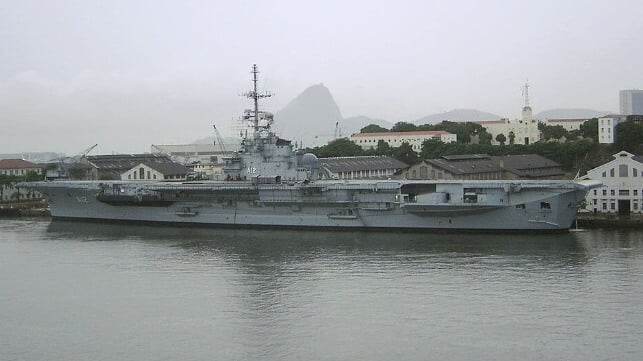Carrier NAe São Paulo Finds Controversy on the Way to the Scrapyard

The decommissioned Brazilian Navy carrier NAe São Paulo has departed Rio de Janeiro for the last time, bound for a scrapyard in Aliaga. Her demolition will sustain jobs and bring in scrap steel material for the local economy, and it has the approval of Turkey's Ministry of Environment, Urbanization and Climate Change, but some members of the local community aren't interested.
According to the NGO Aliaga Environment Platform, the 60-year-old ship has a substantial quantity of asbestos on board, possibly as much as 600 tonnes.
Turkey's Association of Asbestos Dismantling Experts (ASUD) notes that sister ship Clemenceau was found to contain more than 700 tonnes of asbestos when she was sent for scrapping in India. Clemenceau's 10-year saga was an extended and controversial affair: Multiple nations refused to accept her for scrapping (even Alang would not take the carrier) and a specialist yard in England finally won the job in 2010.
São Paulo appears to be encountering the same opposition. Turkey's Warehouse, Shipbuilding and Maritime Transport Union (DGD-SEN) said in a statement that it opposes São Paulo's arrival and will "defend the health of shipbreaking workers." The union described the carrier's demolition as a violation of national law and of the Basel Convention. Izmir Metropolitan Mayor Tunc Soyer also opposes the ship's arrival, according to local media.
However, Environment Minister Murat Kurum has denied that the vessel has much asbestos on board, and he asserts that it poses no threat to the community.
“First of all, nine tons of asbestos is on the ship. Not [600] as mentioned,” Kurum said. “Such works for ships can only be done with international laws. The ship was approved for dismantling after its international controls.”
He added that any asbestos removed from the ship would be packed, kept enclosed and not released into the air. "There are no worries,” Kurum said.
São Paulo began life as the French Navy carrier Foch. She was laid down in 1957 during the midcentury heyday of the "miracle mineral" asbestos, when it was used for everything from insulation to kitchenware to cigarette filters. Foch was commissioned in 1960 and served in a variety of missions for France over the next four decades, including combat tours in the Adriatic during the Bosnian War in the early 1990s. She was sold to Brazil in 2000 as a replacement for the Brazilian Navy's aging WWII-era carrier.

that matters most
Get the latest maritime news delivered to your inbox daily.
In Brazilian service, São Paulo was used for flight qualification training for pilots, as well as a number of exercises. However, the aging carrier suffered from mechanical problems and low reliability. She sustained two serious fires, once in 2005 and again in 2012. In 2017, the Brazilian Navy decided that further investment in repair would be uneconomical, and it formally decommissioned her in 2018. Plans to turn the ship into a museum did not materialize, and on August 4, the AHTS Alp Centre took her in tow for a final transatlantic journey to Aliaga.
